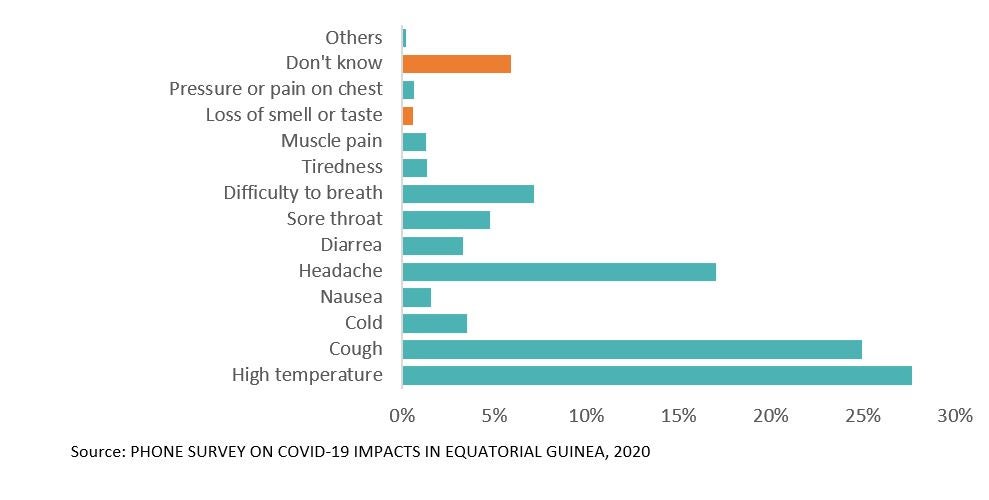 COVID-19 socio-economic impacts in Equatorial Guinea: what data shows
COVID-19 socio-economic impacts in Equatorial Guinea: what data shows
With the first case of COVID-19 confirmed on March 14, 2020, the Equatorial Guinea (EQG) government declared a state of alarm, closing the borders, suspending school classes, forbidding gatherings in the country. When the situation improved in mid-June 2020, the first phase of easing of measures began.
The World Bank, the National Statistics Office of Equatorial Guinea (INEGE) and the phone company GETESA carried out a High-Frequency Phone Survey (HFPS) to measure COVID-19 impacts on the population. Over 1,000 interviews were conducted between the Insular and Continental regions of the country, in both urban and rural areas between November and December 2020. The questions covered household composition, preventive measures taken by households, economic shocks they faced, and mitigation measures taken, their satisfaction levels with government measures, as well as the impact on education, employment, and health.
Data showed that even after 9 months since the start of the pandemic, 6% of the population still could not recognize COVID-19 symptoms and only 27% and 25% recognized high temperature and cough, respectively, as the main symptoms. Knowledge of preventive measures was more universal with 97% of survey respondents reporting that they washed their hands more frequently and more than 90% reporting they avoided gatherings or physical greetings. More than 90% were also satisfied with the government’s measures to mitigate negative impacts of the pandemic and the lockdown.
COVID-19 symptoms recognized

COVID-19 mitigation measures severely affected employment, causing job losses among half of the surveyed workers during the pandemic.
Labor market impacts and closure of education centers were the most important challenges. The government’s responses included creating educational programs launched in the local radio and television, which had the participation of 38% of students from the Continental Region and 28% of students from the Insular Region. In addition, 33% of students received tasks assigned by the teachers while 26% of students participated in individual classes. Unfortunately, only around 40% of households surveyed have access to the internet – internet plans are very costly - which is a barrier to both virtual study and virtual work. Also, some households, mainly in the rural areas, don’t have access to electricity, and therefore no internet access.
Learning activities during the confinement period

Ensuring food security was a challenge, even though it was four months since economic activity had started recovering with the gradual easing of measures. Our survey showed that 48% of households lacked a diverse diet, 43% lacked healthy food and 23% reported going without eating for a whole day in the last 30 days before the survey.
Since the phone survey, EQG has faced four waves of COVID-19. New decrees gradually easing the preventive measures were adopted. Schools and most businesses reopened, but with capacity limited to 50% and facemasks mandated, along with social distancing in restaurants, pubs, and shops.
Anticipating the lockdown negative impacts on non-oil taxes recovery (-25.9% in comparison with 2019, what could be worse), EQG’s authorities preferred increasing (8.3%) oil production to have more revenues and be able to face additional COVID-19 related expenditures (0.5% of total expenditures in 2020). With this decision, the GDP registered a -4.2% growth rate while it was estimated at -4.9%. The country continued developing the hydrocarbon sector with the backfilling project in natural liquified gas, which allowed an -0.9% estimated growth rate in 2021. The government was able to face expenditures increase due to COVID-19 (2.8% of total expenditures in 2021). Vaccinations went up, making EQG one of the highest vaccination rates countries in Africa, even though it remains quite low with 17.6% of the population being partially vaccinated as of April 2022. The government launched the third vaccine dose in February 2022 to increase protection, notably for the high-risk groups.
In our personal experience, adherence to preventive measures such as face mask, vaccine, 1.5 meters of social distancing and 50% capacity restriction is lower than in earlier phases of the pandemic, probably because of restrictions fatigue and epidemiological curve’s decline (5.4% is the current positivity rate). Some may believe COVID-19 no longer exists or feel protected as they are vaccinated even though the protection from their second dose could have waned with the passing of time.
We believe that the battle against this virus can be won in EQG through the population’s collective efforts in vigilance, prevention, and mitigation with government support, which is particularly needed for raising awareness about the importance and effectiveness of vaccination, including among children. Government policies also have a critical role to play in spurring economic recovery from the effects of the pandemic. The design of such policies can be informed by the findings of HFPS 2020 and those of the second round of the survey (conducted in June-July 2021) that will soon become available.1
1with thanks to Jose Montes, Remy Monlouis-Bonnaire, Johan Mistiaen, Ambar Narayan for their comments


Join the Conversation